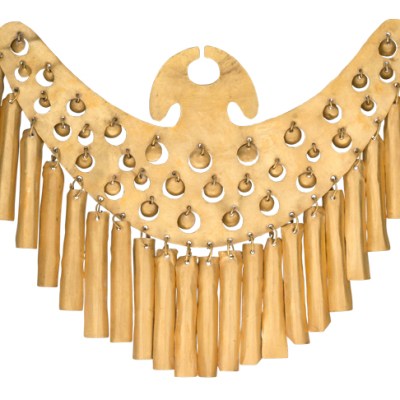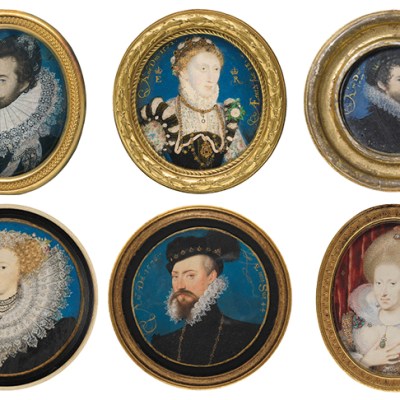There is a Japanese proverb, ‘jyuu nin, to iro’, which translates literally as ‘ten people, ten colours’. It conveys the meaning that, given the chance, every person will choose something different. The V&A’s recently reopened William and Judith Bollinger jewellery gallery is a space in which you imagine not only ten but a thousand people could choose a different favourite object; there are perhaps even that many colour varieties among the 3,500 pieces on display. The gallery spans 3,000 years of European history, taking visitors on a journey that starts with ancient Greek goldwork and arrives at the splendid ‘Papillon’ ring donated by Beyoncé. Along the way the display, arranged chronologically with interspersed thematic sections, presents everything from medieval reliquary pendants to a necklace made from discarded vials formerly housing an altogether different precious substance – crack cocaine – and found by the artist Jan Yager on the streets of Philadelphia.
While the layout of the gallery remains familiar, the infrastructure has been refreshed and sharpened up, with glass replacing Perspex in Atelier A&D’s mezzanine staircase, new flooring, and sophisticated lighting. The audio-visual displays have also been updated, designed to withstand the demands of an increasingly digital-hungry public who have visited the gallery in their millions since it originally opened in 2008.
Gold vanity case decorated with blue, black and white enamel and diamonds, with a suspension chain with finger ring (1923–25), Lacloche, Paris. Courtesy Victoria and Albert Museum, London

While the curators explicitly position craftspeople as the the ‘heroines and heroes’ of the story, it is no coincidence that some of the most alluring new objects on display have celebrity connections. A sapphire and diamond coronet designed by Prince Albert and worn by Queen Victoria is a star attraction on the lower level, while on the mezzanine one finds a group of 49 stunning vanity cases dating largely from the 1920s and ’30s, collected by Kashmira Bulsara and promised to the museum in memory of her brother, Freddie Mercury. Yet the latter are not simply on show for their star quality – at the time the V&A did not collect much in the way of objects we would now call Art Deco, and these cases fill a gap in the collection’s overarching narrative.
Gold, coral and diamond-set vanity case with laque burgauté panels (1924), Cartier, Paris. Courtesy Victoria and Albert Museum, London; © Cartier International AG

In comparison with many of the V&A’s grand Victorian spaces, the jewellery gallery, conveniently located off the museum’s main staircase, feels immersive; the intimate scale and soft lighting complement the deeply personal, private associations of the medium. The presentation of so many objects within a relatively confined space allows visitors to easily see developments in style and technique, and to draw comparisons with objects separated across centuries. A striking display of Berlin ironwork, jewellery made fashionable when gold was in short supply during Prussia’s campaign against Napoleon, is an early anticipation of more modern pieces made from acrylic, paper, and other non-precious materials.
Close juxtaposition of objects also illuminates ideological and stylistic controversies; visitors can take in the height of late-Victorian bling in the same breath as the Arts and Crafts jewellery that reacted against it, such as a selection of pieces by May Morris that highlight the natural qualities of semi-precious stones.
Queen Victoria’s sapphire and diamond coronet (1840–42), designed by Prince Albert, made by Joseph Kitching, London. © Victoria and Albert Museum, London

The inclusion of designers such as Morris, better known for her embroidery and wallpaper designs, and her contemporary Henry Wilson, an Arts and Crafts jeweller who also worked as an architect and metalworker, is a reminder of jewellery’s relationships with objects across all media. Medieval pendants on display echo the sacramental metalwork on show in the nearby silver galleries while the sculptural properties of an agate cameo by the Franco-German artist Jean Georges Bissinger (another new acquisition), brings to mind the statuary elsewhere in the museum.
The encyclopaedic nature of the gallery underscores its intrinsically educational nature, a purpose that is, after all, the museum’s raison d’être. While the focus is undoubtedly on exploration rather than didacticism, it would nonetheless be difficult to leave the room without having learnt something about the history of European jewellery. Of course this higher purpose does not mean that the curators neglect to capitalise on the twinkling allure of their subject matter – at the entrance, visitors are drawn in with a mesmerising polychromatic display of 183 rings formerly in the collection of Reverend Chauncy Hare Townshend. For Townshend, friend of Charles Dickens, poet and indefatigable collector of gemstones, it seems that one colour was simply not enough.


